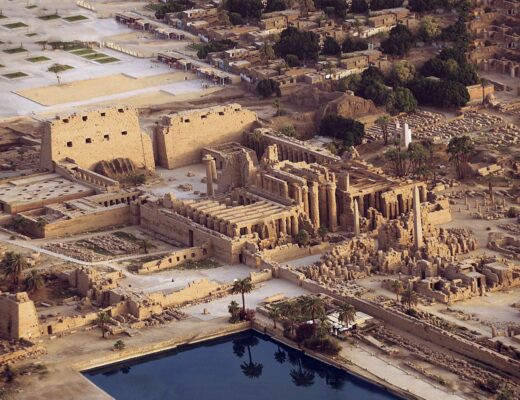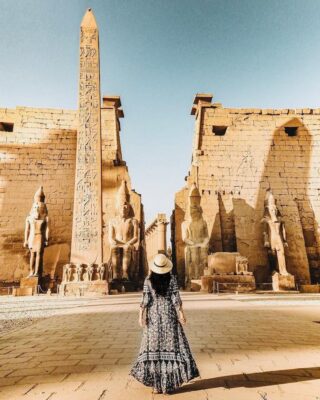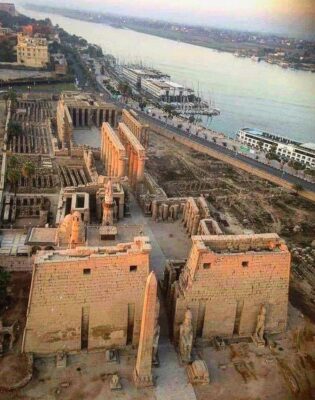Luxor Temple, located in the heart of Luxor, Egypt, is one of the most iconic and well-preserved monuments from the ancient world. This stunning temple is a testament to the grandeur of the Pharaohs and their remarkable architectural achievements. Its intricate design and historical significance make it a must-visit destination for those looking to explore the wonders of ancient Egypt. Let’s explore the mysteries with archeology.dulichvn.net

1. The History of Luxor Temple
1.1 Origins and Construction of Luxor Temple
Luxor Temple was originally constructed during the reign of Pharaoh Amenhotep III in the 14th century BCE, later expanded by other great rulers like Ramses II and Tutankhamun. The temple was dedicated to the Theban Triad, primarily to the god Amun, along with his consort Mut and their son Khonsu.
1.2 Purpose and Religious Significance
Luxor Temple played a significant role in religious ceremonies, especially the annual Opet Festival, which celebrated the power and divinity of the Pharaoh. The temple served as a central place of worship, where kings and priests performed rituals to honor the gods and renew the king’s divine power.
1.3 The Influence of Luxor Temple on Egyptian Architecture
The temple’s design reflects the sophistication of ancient Egyptian architecture, with its grand pylons, towering obelisks, and expansive courtyards. It influenced many subsequent architectural projects and is considered a masterwork of design and construction.

2. Architectural Marvels of Luxor Temple
2.1 The Grand Entrance and Pylons
The first thing visitors notice upon arriving at Luxor Temple is its magnificent entrance, dominated by massive stone pylons, which create a dramatic entrance. These pylons feature intricate reliefs depicting the Pharaohs in battle and in the company of the gods.
2.2 The Colossal Statues of Ramses II
Ramses II, one of Egypt’s most powerful and influential Pharaohs, left a lasting mark on Luxor Temple. His monumental statues, standing guard at the entrance, serve as symbols of strength and divine protection.
2.3 The Sacred Lake and Courtyard
At the heart of Luxor Temple lies a large sacred lake, used for purification during religious ceremonies. The courtyard, with its rows of statues and towering columns, is a magnificent space that gives a glimpse into the grandeur of ancient Egyptian architecture.

3. The Legacy of Luxor Temple
3.1 A Symbol of Egyptian Power and Religion
Luxor Temple symbolizes the enduring legacy of the Pharaohs and their divine right to rule. It was a center for religious worship, representing the connection between the gods and the Pharaohs, who were seen as living gods on Earth.
3.2 Preservation Efforts and Ongoing Excavations
Efforts to preserve Luxor Temple have been ongoing for centuries, with excavations and restoration projects revealing new insights into ancient Egyptian culture. Today, the temple remains one of the most well-preserved and significant monuments of Egypt’s New Kingdom.
3.3 Luxor Temple’s Impact on Modern Architecture
Luxor Temple’s influence extends far beyond the ancient world. Its architectural elements, such as grand columns, obelisks, and massive statues, have inspired many modern architects and can be seen in various structures around the world.
See more: Interesting Facts About Trajan Rome’s Great Emperor
Conclusion
Luxor Temple stands as a testament to the extraordinary achievements of ancient Egyptian civilization. Its awe-inspiring architecture and rich history make it an essential stop for anyone exploring the wonders of Egypt. A visit to Luxor Temple offers a rare opportunity to connect with the divine legacy of the Pharaohs and experience the timeless beauty of one of the world’s greatest ancient monuments.


CÁC TIN KHÁC
Mark Twain & Olivia Langdon: A 36-Year Love Story Filled with Laughter and Devotion
The Tollund Man: A 2,400-Year-Old Mystery Preserved in a Danish Bog
Skara Brae: Scotland’s Hidden Neolithic Village
Porta Nigra: The Hidden Depths of Trier’s Iconic Roman Gate